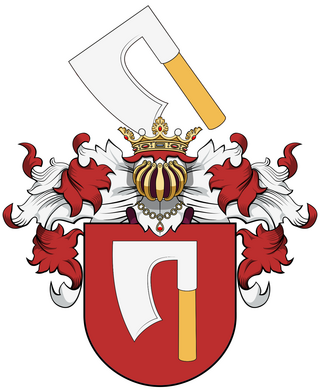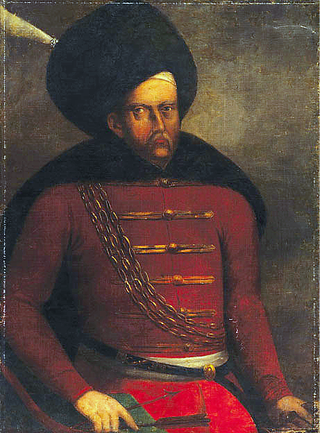
Halych is a historic city on the Dniester River in western Ukraine. The city gave its name to the Principality of Halych, the historic province of Galicia (Halychyna), and the Kingdom of Galicia–Volhynia, of which it was the capital until the early 14th century, when the seat of the local rulers moved to Lviv.

Berezhany is a city in Ternopil Raion, Ternopil Oblast, western Ukraine. It lies about 50 km (31 mi) from the administrative center of the oblast, Ternopil. Berezhany hosts the administration of Berezhany urban hromada, one of the hromadas of Ukraine. Population: 17,139.

Zbarazh is a city in Ternopil Raion, Ternopil Oblast, western Ukraine. It is located in the historic region of Galicia. Zbarazh hosts the administration of Zbarazh urban hromada, one of the hromadas of Ukraine. Population: 13,346.

Budaniv is a village in Chortkiv Raion, Ternopil Oblast, in western Ukraine, near Terebovlya. It belongs to Bilobozhnytsia rural hromada, one of the hromadas of Ukraine. The population of Budaniv is 1,634 (2005). Before World War II, the village and its surroundings were part of the Second Polish Republic.

The Principality of Galicia, also known as Principality of Halych or Principality of Halychian Rus', was a medieval East Slavic principality, and one of the main regional states within the political scope of Kievan Rus', established by members of the oldest line of Yaroslav the Wise descendants. A characteristic feature of the Galician principality was the important role of the nobility and citizens in political life, and consideration a will which was the main condition for the princely rule. Halych as the capital mentioned in around 1124 as a seat of Ivan Vasylkovych the grandson of Rostislav of Tmutarakan. According to Mykhailo Hrushevsky the realm of Halych was passed to Rostyslav upon the death of his father Vladimir Yaroslavich, but he was banished out of it later by his uncle to Tmutarakan. The realm was then passed to Yaropolk Izyaslavich who was a son of the ruling Grand Prince Iziaslav I of Kiev.

Terebovlia is a small city in Ternopil Raion, Ternopil Oblast, western Ukraine. Terebovlia hosts the administration of Terebovlia urban hromada, one of the hromadas of Ukraine. Population: 13,226 ; 13,661 (2001).

Skalat is a small city in Ternopil Raion, Ternopil Oblast, western Ukraine. It hosts the administration of Skalat urban hromada, one of the hromadas of Ukraine. Population: 3,739.

Volodar Rostislavich was Prince of Zvenigorod (1085–1092) and Peremyshl' (1092–1097).

The siege of Zbarazh was fought near the site of the present-day city of Zbarazh in Ukraine between the Cossack Hetmanate and Crimean Khanate against the Polish–Lithuanian Commonwealth as a part of the Khmelnytsky Uprising. The siege lasted for seven weeks.

The Khotyn Fortress is a fortification complex located on the right bank of the Dniester River in Khotyn, Chernivtsi Oblast (province) of southwestern Ukraine. It lies within the historical region of northern Bukovina, a Romanian territory occupied in 1940 by the Soviet Union following the Molotov–Ribbentrop Pact. The fortress is located near another famous defensive structure, the Kamianets-Podilskyi Castle. Construction of the current stone Khotyn Fortress began in 1375. The fortress underwent significant improvements in the 1380s and in the 1460s under the Moldavian princes Alexander the Good and Stephen the Great.

Kamianets-Podilskyi Castle is a former Ruthenian-Lithuanian castle and a later three-part Polish fortress located in the historic city of Kamianets-Podilskyi, Ukraine, in the historic region of Podilia in the western part of the country. Its name is attributed to the root word 'kamin', from the Slavic word for 'stone'.

The House of Tęczyński was a powerful family of nobility (szlachta) in the Kingdom of Poland, during the times of the late Piast dynasty, the Jagiellon dynasty and in the early decades of the Polish–Lithuanian Commonwealth. They were an important family from Lesser Poland (Małopolska), active in Polish politics of their time.

The Ternopil Castle is a stronghold which gave birth to the city of Ternopil. It was built in the 16th century to protect the southern border of the Kingdom of Poland and the Polish–Lithuanian Commonwealth.
Andrzej Tęczyński, Count, was a voivode of Lublin, voivode of Sandomierz, voivode of Kraków, Castellan of Kraków. He came from one of the most powerful clans in Lesser Poland, the Tęczyński family.

Bernard Pretwicz was a Silesian noble of the Pretwicz family. After entering the service of the Polish King at a young age and leading a successful military career, he became a rittmaster of the obrona potoczna, and later the starosta of Bar and Ulaniv (1520–1552) and Terebovlia (1552–1561). He was widely known in Poland and Ukraine for fiercely protecting the borders of the Kingdom of Poland from Crimean Tatar raids, which earned him the nicknames of Terror of the Tatars and Wall of Poland.

Bilokrynytsia Palace is the original castle in Bilokrynytsia of the Ternopil Oblast, built in the 16th century by the Zbaraski family, and an architectural monument of local importance.

Yaniv Castle is a located in Dolyna, Ternopil Oblast, Ukraine. The stronghold was built in the 17th century on a sloping hill by Jan Golski, Voivode of Podolia and Castellan of Halych, brother of Stanisław Golski, Voivode of Rus, and an architectural monument of national importance.

Hrymailiv Castle is a located in Hrymailiv, Ternopil Oblast, Ukraine. At the end of the 16th century, Hrymailiv was owned by the Ludzicki family of the Grzymala coat of arms, who erected a castle here, and an architectural monument of local importance.

Husiatyn Castle is a located in Husiatyn, Ternopil Oblast, Ukraine. Castle built in 1630 on the steep bank of the Zbrucz River, north of the city center, and an architectural monument of local importance.





















